ISSN:2630-5771
Journal of Construction Engineering, Management & Innovation
ARTICLES
Sevilay Demirkesen
Chengyi Zhang
The construction industry needs safer practices due to its complex and fragmented nature. Therefore, making errors visible is essential to the process of error proofing. With the Lean concept, it becomes possible to design out errors and develop ways to prevent errors before they turn into defects. Lean also creates a more productive and effective process when implementing innovative methods such as TRIZ, a problem solving, analysis, and forecasting tool. Lean TRIZ is a new approach to improve construction processes while reducing the likelihood of defects. It strongly coincides with the elimination or possible prevention of errors originating from unsafe actions and conditions. Considering the high number of accidents in the construction industry, it is of utmost importance to implement tools and techniques to prevent the probability of such occurrences. Therefore, this study proposes a new method for error prevention with the implementation of the Lean TRIZ method to minimize safety-related problems in construction. Then, real construction problems caused by unsafe practices and conditions are analyzed with the Lean TRIZ method. The main contribution of the study is to introduce the Lean TRIZ concept and analyze the feasibility of applying this method to solve safety problems. In addition, the study provides a guide and encourages construction practitioners to benefit from the solutions provided by this research in the context of Lean TRIZ methodology.
https://doi.org/10.31462/jcemi.2021.02068079
Emre Caner Akçay
The popularity of public private partnership (PPP) projects has grown all over the world, especially in developing countries. The success of PPP projects heavily depends on how effectively risk assessments are performed. Failure Mode and Effects Analysis (FMEA) enables risk assessment by considering the impact, the probability, and the detection rate of risk events. However, it is very difficult to predict a single value for these variables. The objective of this research is to integrate FMEA and Monte Carlo simulation, and to use this model to perform risk assessment and prioritization of risks in PPP projects. The proposed model was applied to a real wind power generation investment located in the Aegean region of Turkey. The top three important risk events are “unfavorable wind speed”, “fluctuation in exchange rates”, and “interest rate volatility”. The model perfumed to the satisfaction of experts. The primary contributions of this research include (1) a method that allows the identification of the risk events in PPP projects; (2) a model that performs risk assessment and prioritization of risk events in PPP projects; (3) an integrated FMEA and Monte Carlo simulation model that performs stochastic risk assessment in PPP projects. Both public agencies and private consortia should benefit from the proposed model.
https://doi.org/10.31462/jcemi.2021.02080091
Zeynep Birgonul
Oriol Carrasco
The new horizon for research & development in AEC is directed through an interdisciplinary design-thinking approach. The design paradigms are not only as they were about form and function but now also about efficiency, sustainability, productivity, desirability, feasibility, and viability in current day. As a result of this approach, the term design innovation approves oneself. Correspondingly, emerging technologies such as robotic fabrication & construction tools, self-fabrication & assembly, information and communication technologies, computer science and related software technologies, enable the designers and engineers to push the edges of their creativity, productivity and sensitivity upon global issues. The emergence of those new technologies is defined as digitalism, and both academy and industry have almost totally adapted to this digital-design thinking approach. Consequently, the smooth communication between machines, makers and designers dominates the progression in architecture, science, technology and engineering. However, because of this shift, a research gap has emerged between new academic research and classical industrial production as theory and practice do not overlap anymore. For the adoption of this emergent holistic design-thinking approaches; a new learning methodology has been introduced by the authors under the title of 'Multidimensional Exploration Methodology'.
https://doi.org/10.31462/jcemi.2021.02092105
Fatemeh Mostofi
Vedat Toğan
Hasan Basri Başağa
High dimensionality and skewness are two intrinsic characteristics of the real estate dataset, that affects the price prediction accuracy of deep neural network (DNN). The objective of this study is to investigate the effect of skewness in prediction accuracy of combined principal component analysis (PCA) with the DNN (PCA-DNN) model. This research follows a threefold approach over a high dimensional and positively skewed real estate price dataset. Firstly, data distribution is to conform with normality using three conventional skewness reduction techniques, namely square root transformation (SRT), cube root transformation (CRT), and logarithmic transformation (LT) methods. Secondly, the high dimensionality of original, SRT, CRT, and LT skewed datasets are to be reduced using PCA. Thirdly, the price prediction accuracy of the PCA-DNN model over datasets with different skewness levels is to be compared by observing their error values. The results suggest that the CRT method can considerably improve both prediction accuracy and computational time of the PCA-DNN model while displaying a good generalization ability. Despite the CRT method, SRT and LT methods resulted in high error values and overfitting issues, respectively.
https://doi.org/10.31462/jcemi.2021.02106116


